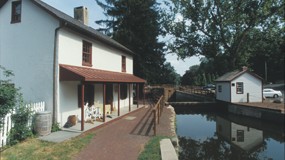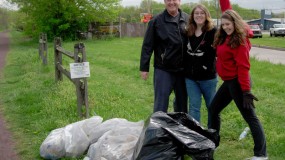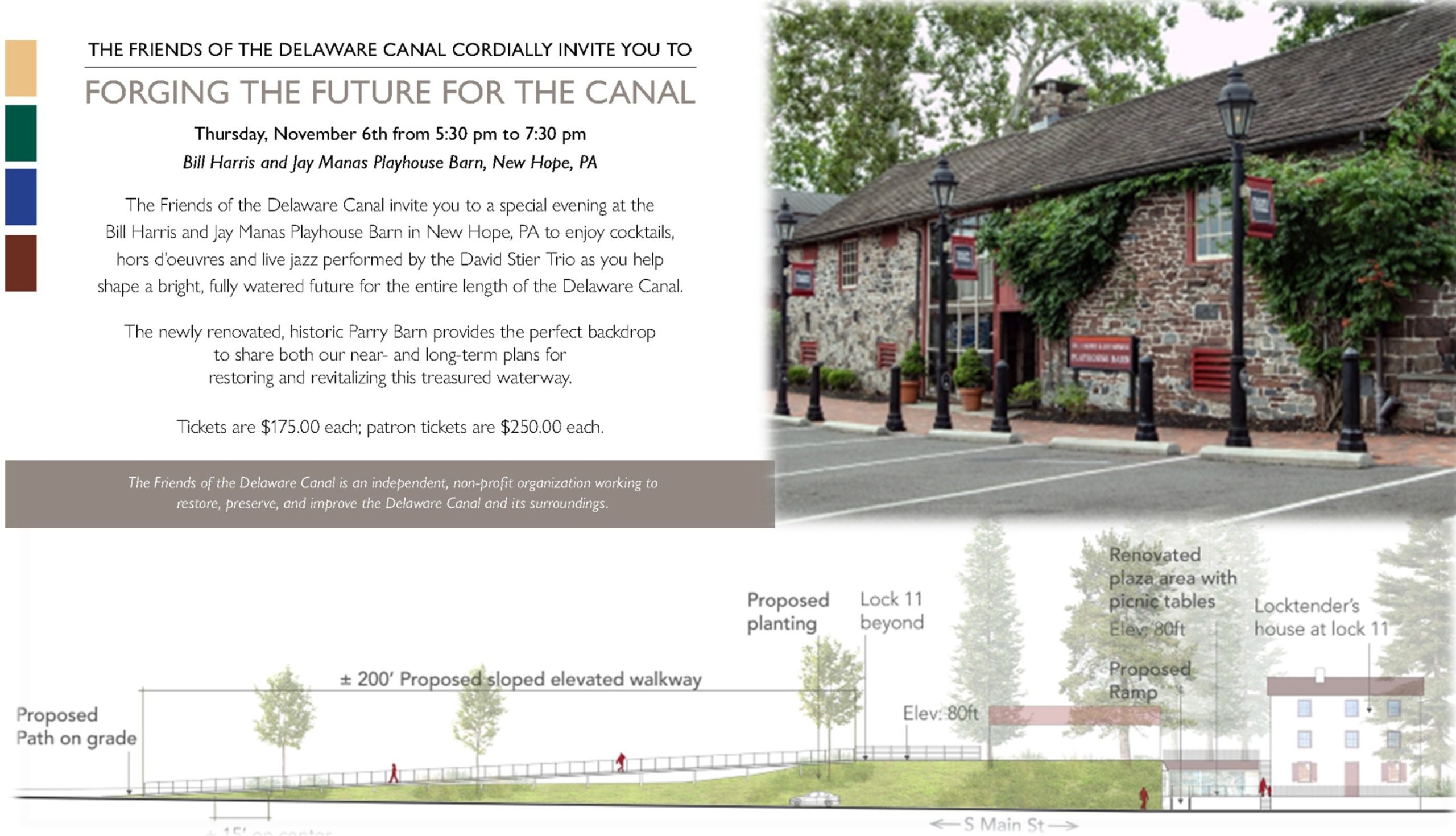Woody’s Camelback Bridge is Restored, Thank You!
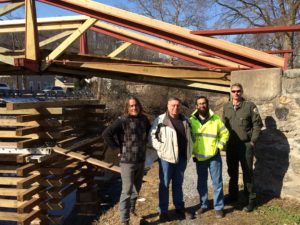
Twas the week before Christmas when contractor Randy Myer of R-Shell Exteriors arrived at the Woody’s Camelback Bridge work site south of Easton. Almost single-handedly, Randy assembled the cribbing to support the bridge structure, dismantled the deteriorated parts, and then undertook the carpentry and metal work necessary for the restoration. He worked while frigid winds blew and the ground was snow-covered all to accomplish his goal of having the job done by mid-February.
Woody’s Camelback Bridge is now the fifth of the six authentic camelback bridges to be restored. Randy did a masterful job! The work has been inspected and approved by the State engineers, and all that remains to be done is to stain the wood when it has aged a bit and the weather is warmer.
The restoration of this historic camelback bridge would not have been possible without the financial support of those Friends who made contributions specifically for this project during the Year-end Appeal. Our organization was able to pay for the labor costs solely using new contributions designated for Woody’s. The PA Department of Conservation and Natural Resources paid for the materials.
The Friends gratefully thank the 37 supporters of Woody’s Bridge, of whom the following made major donations:
The Goodfellow Fund
William Farkas
Robin and Jeff Connell
Judy and Joe Franlin
Carole and Fred Mebus
Barbara and Peter Sperry
Anonymous
AND thanks to the unprecedented generosity of all of our Year-End contributors, the Canal Improvement Fund now has a balance that beckons another project.
A historic, picturesque, and useful camelback bridge has been preserved and funds are available to tackle another improvement initiative. May the coming year continue on this positive track.
__________________________________________________________________
At the Board Table
Board member Bill West left the Board in February because of his extended out-of-state time commitments. Always enthusiastic about Friends’ fund-raising events, Bill was a key player in making them happen. He was also tuned into what was happening along Canal because of his frequent and far-reaching walks along the towpath. Bill, we’ll miss you!
*******
All the members of the Board of Directors welcome your assistance questions, and advice. If you are interested in learning more about becoming involved in a Friends’ committee or becoming a member of the Board, please contact President Brett Webber at bw@bwadesign.com
____________________________________________________________________________________
Park Manager’s Report
Well, I thought we were going to have an early spring this year, but Mother Nature proved me wrong. Nothing like a blizzard to test the endurance of our park maintenance crew.
The Lower Limeport Bridge replacement project in Solebury Township is progressing, but the contractor ran into a problem with the east bridge abutment. It was found that the abutment was built on top of rubble and loose soil instead of a concrete foundation. The contractor has demolished the old abutment and will be building a new concrete abutment with a concrete foundation to remedy the issue.
Design work still continues for the Phillips’ Mill bridge project, also in Solebury Township. The design consultant is still working with PennDOT to work through some issues and obtain a Highway Occupancy Permit.
Since my last Park Manager’s Report, we have had another stone wall collapse in New Hope by the Waterworks Condominium Association property. This collapse was a little larger than some of our previous wall repairs, but the Park was able to hire a contractor and make the repairs within a few weeks.
The Woody’s Camelback Bridge restoration and repair work has been completed. Thank you to the Friends of Delaware Canal for all of your help and fundraising efforts to make this project happen.
Finally, we have several sinkholes in the northern section of the canal that need to be repaired before we can start filling the Canal from the Lehigh River. The sinkholes are located by the Easton Sewage Treatment Plant, by the Blue Moon in Raubsville, between bridges 2 & 3 in Smithtown, and one just south of the Virginia Forrest Recreation Area. Our plan is to begin these repairs as soon as weather permits, and the towpath is in suitable condition to operate heavy equipment. We will then start adding water from north to south as we complete repairs.
Enjoy the Canal. Josh Swartley
______________________________________________________
Oh Where, Oh Where Could that Little Egg Be
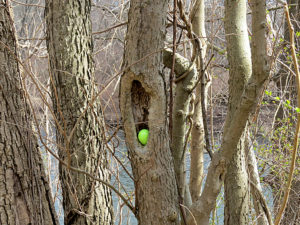
On April 9th one dozen eggs will be hidden along the Canal from Easton to Bristol. Find one and your prize will be a Friends of the Delaware Canal t-shirt. Just follow the instructions inside the egg. Happy Hunting!
__________________________________________________________________
Welcome, New Friends
Michele Becci
Elizabeth Bennett
Lou Bristol
Neal Carson
Barbara Dalglish
William R. Krisak
Tamara Lesh
Jean McBryar
Kent Nash
Peggy Navitski
Suzanne Stahl
Inge and Christoph Stannik
Dave Sutton
New Signs with Improved Maps
The PA/NJ Canal Loop Trail system is marked with 12 signs located near to where the towpaths and the river bridges intersect. The signs have been providing information to park visitors for more than 13 years. Age has caught up with the fiberglass imbedment panels, and most now are deteriorated to the point that they cannot be read.
A grant from the Bucks County Conference and Visitors Bureau (Visit Bucks County) has enabled the Friends to have new panels fabricated and to purchase a sign base to replace one that was damaged by a truck. The new panels will feature a new and improved map that provides more information about distances and graphics that are easily understood.
The PA/NJ Canal Loop Trails are increasingly popular because of their convenience. We thank Visit Bucks County for helping us to keep canal visitors informed and entice them to return to discover even more intriguing places.
Sharing the Towpath Trail
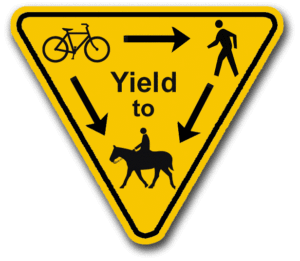
With Spring comes the return of lots of visitors to the Delaware Canal towpath. Please be mindful of your fellow Park users.
_______________________________________________________
A Revelation from the North
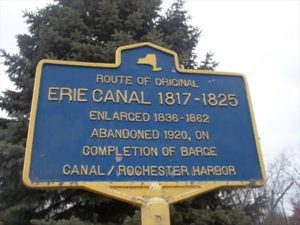
By Susan Taylor
Date: Saturday, March 4
Place: Rochester, NY
Event: The Canal Society of New York State Winter Symposium
Outside the temperature was 13 degrees and the wind was shipping, but inside the community college conference center sat 100+ devotees of the Erie Canal – the canal that “changed America.” – the canal that spurred Pennsylvania legislators and entrepreneurs to jump into canal building whole hog – the canal that today is a tourism and economic development powerhouse.
At 9 a.m. those 100+ people were ready to view my presentation about the Delaware Canal. I showed the Canal at its best and worst during my “Commerce, Calamities and Conservation” PowerPoint with particular emphasis on how and why the waterway was preserved, the Canal’s comeback after the four recent floods, and how the Friends of the Delaware Canal have influenced the future of the Canal.
Why was I invited to speak? I was told that there were many small organizations under the Society’s umbrella that could learn from what the Friends have accomplished and that my program might be the inspiration for a field trip in 2018.
The presentation went well. There were ahhs when particularly beautiful photos of the Canal were projected, gasps at the extent of the flood damage, and questions at the end.
But what happened after I left the podium sparked a revelation. At least six people came up to me to say how lucky we were to still have a real canal — one that has many of its historic structures, has its same dimensions, and looks to a good extent as it did in the 1800’s. To my mind, these were people who were dealing with a very superior canal, but still they envied what we have on the Delaware Canal.
The experience drove home the ever-present need to evaluate and then vigilantly guard what makes the Delaware Canal so special. Change can be stealthy and manifest itself in tiny, virtually unnoticeable increments. Each time that the silt in the bottom of the Canal is simply pulled to the bank and not removed, the capacity of the water channel decreases. The action doesn’t seem like much at the moment, but over time ….. Dramatic change can come cloaked in “necessity,” “economic feasibility,” and “redevelopment.”
Change is unremitting and often comes with excellent results, but we must be mindful not to lose the attributes of the Delaware Canal that make it special, loved, and even envied.
Sharing Expertise
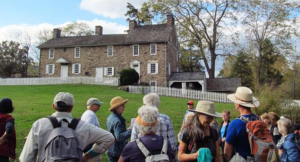
Pennsylvania is blessed with a wealth of parks, forests, and historic places. A visit to a Commonwealth-owned property will, in nearly every case, involve both an experience with nature and a contact with a historic place. For instance, the northern section of Washington Crossing Historic Park has within its boundaries the Thompson-Neely House and Soldiers’ Graves as well as picnic pavilions, a Boy Scout camping ground, not to mention the Delaware Canal running through it.
Good administration of Pennsylvania’s diverse resources takes a wide range of expertise. Knowledge about recreation, sustainability, preservation and maintenance practices need to be shared in order to best protect the State’s irreplaceable treasures.
Currently the protection of these treasures is the responsibility of two different State agencies. Under the structure of Commonwealth of Pennsylvania government, the Department of Conservation and Natural Resources (DCNR) is responsible for conserving and sustaining the State’s natural resources and the Historical and Museum Commission (PHMC) is responsible for collecting, conserving, and interpreting the State’s historic heritage.
This March an important step was taken to ensure that expertise is shared. DCN and PHMC are in the process of developing a formal consultation agreement that facilitates working more closely together on issues of management, conservation, and preservation of the historic resources under DCNR’s ownership.
John Hallas, Director of the PA Bureau of State Parks, lauds this step forward. “DCNR, as a significant steward of the Commonwealth’s cultural resources, is looking to make major improvements in our management practices for historic assets.” He added that another positive aspect of the enhanced DCNR/PHMC relationship is that DCNR is launching a first-ever cultural resource plan for Point State Park in Pittsburgh. PHMC consulting services and mitigation funding will be used to develop the plan, which will serve as an archetype for incorporation into DCNR’s park-specific planning documents.
In Working Order Again
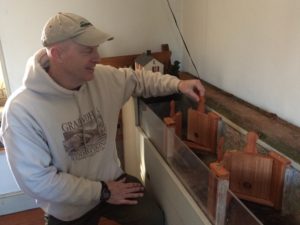
The canal lock model at the Locktender’s House in New Hope provides the hands-on answer to the question “How does a lock work?” Built more than 15 years ago by a Palisades High School teacher and his students, the model features flowing water and a lock chamber in which a little boat can be raised and lowered. Best of all, it has never leaked.
Over the years the model lock gates and their wickets have been pulled and pushed tens of thousands of times by kids and adults. All that use wore out the gates, ad they were no longer able to hold water back making the demonstration of locking through impossible.
Several attempts were made to build new gates, but none worked properly. Then to the rescue came woodworker Josh Gradwohl. (You may recognize the name since Josh built the Locktender’s House garden fence, the front door, and replaced the mural plaza fascia boards.) Josh took all the old gates home, studied them, and devised a new gate design. The new gates are crafted from wood, which provides a more accurate depiction of real lock gates, and their miter joints are tight– all the better to illustrate the water levels inside and outside the lock chamber.
Josh once again shared his abilities as a fine craftsman with the Friends, and we are so grateful. This spring the lock model will be filled with water, and visitors will be able to lock a boat through all by themselves.
